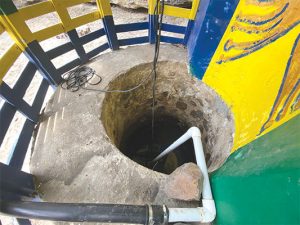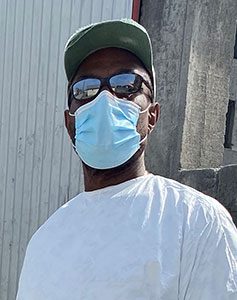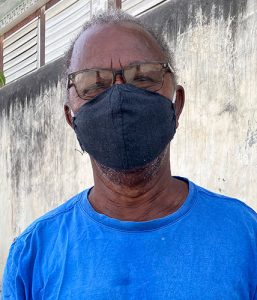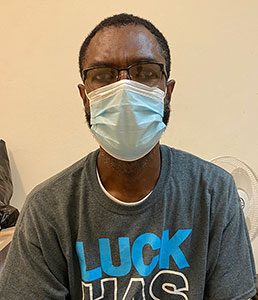CWSA working tirelessly to clear water systems of ash

Volcanic ash released by La Soufrière’s explosions last week choked the country’s water systems.
And thousands of residents, including those who had been evacuted, were desperate for the precious commodity as taps ceased to flow.

The shelves of supermarkets and groceries quickly emptied of bottled water and people resorted to abandoned traditonal sources such as springs to augment or replace what had been stored but had all been used up or run low.
There were some areas such as Green Hill served by smaller systems that had water for some periods during the past few days.
Teams from the Central Water and sewerage Authority-CWSA-worked tirelessly to clean their systems of ash and restore supplies to the population and at the time of going to press, officials there said they were able to get back up to 70 per cent capacity.
Work was undertaken at all the systems, which are fed by rivers that had all become contaminated by the ash dumped by last Friday’s violent blast ofthe volcano. The Hermitage system on the Leeward side in Spring Village mountain, as well as Jennings in the Mount William/Byera Hill area that supplies the north east corridor, still had to be dealt with yesterday. By the end of that day, however, Jennings had been restored, and was being filled for pipeline distribution today, and Hermitage was on its way to restoration.

The CWSA in the interim, resorted to delivering water to shelters and other residents, using huge tanks on trucks, but many people did not receive a supply.
Barrouallie, supplied by the Hermitage system, had been without pipe-borne water since Saturday, leaving the community to fall back on water that the CWSA had asked them to store prior to the eruption.
A huge tank on the wharf that was supposed to supply water to the town on Wednesday April 14, remained empty that morning as the vessel that was supposed to fill it could not dock in the shallow area.
Vaughn Kirby, a resident of the central leeward town, stood in front of his house where the ash has piled up, beside a few volunteers sweeping the tiny lava particles out of the road, while clouds of dust rose up, undoing some of the job that was just done. Vehicles drove by, raising more dust. But whatever water the community has cannot be used for this task.

“So we’re getting a big problem right now with the air quality in the town, and the roads need to get cleaned,” Kirby commented.
He revealed that their situation is that, “we had (pipe-borne) water two days ago for a couple of hours, since then we haven’t had water. There’s a truck coming in the community, giving out water to people on the road.”
Garvin Williams, another resident, spoke about the woes of locating the water truck which cannot get to all of the roads in the town.
“It very hard, and the dust, we can’t open our windows, so when we inside the house and we locked up inside the house, is heat and dust, so in general we really need some water,” he said .
Another resident who was media shy, commented: “the most difficult thing in not having water these few days is like small children, especially babies and they need water, that their body go get dehydrated, so they need some water.”
“…Even in the (emergency) camps up there, they not getting much water…”.
The water they got for the short period of time on Tuesday, trickled through at low pressure, “they not keeping on the pipe long enough that people can get more things filled than just two hours. Sometimes when it open, other people in different areas fulling, and some people in some areas the water not reaching to their pipe,” she said.
The Central Leeward Secondary School, an emergency shelter in Peter’s Hope did not have water by Monday, and had to fall back on resourceful means, driving to Buccament to truck some water.
However, the school was also sitting on a cistern that had been built underneath it during its construction, containing gallons of water.
“We knew of the water being under there, it’s a cistern, constructed under the tuck shop and so a decision is taken to have the water tested, so at this moment we use it, not for drinking purpose. We using it for washing and so on,” the Principal, Kenneth Holder revealed.

The cistern can support the shelter currently with 108 registered persons, with 67 residing, comfortably. The school also had tanks which had been refilled by the CWSA.
“I guess it’s the foresight of the Government because 12 or so years ago, they decided, when they constructed the building, they did that with that vision in mind, and this is not the only one – that’s the thrust of the Government regarding the newer schools,” the Principal said.
JP Eustace Secondary and West St George are also schools said to have this supply.
When the disaster hit, many looked to the ground for water. The CWSA carried out a successful abstraction of a groundwater well in Pembroke, being used to supply water to the emergency shelters on the Leeward side. The CWSA said it knew where the well was so it could be accessed when necessary.
At Questelles beach, another historic well is being put to use. While many beachgoers had used it as a refuse dump the well was cleaned up by the non-profit organization the “Questelles Beach Keepers”, and the stagnant water drawn out. It was covered, and a barrier built.
Along the windward corridor, many flocked to a well at Argyle, said to have been used in an earlier time to provide water that powered an arrowroot mill.
And many sought out the spa at Gomea to fill up.
The CWSA cannot say exactly when the systems will all be back up and running fully, and Public Relations Manager, Joan Ryan noted: “we just want to ensure that people understand that this is a difficult time. We understand that this is a difficult time and we are working hard to ensure that persons receive water. The very fact that we have been getting assistance from outside of the country in terms of the supply of water has been a big help.”
She explained that creating a schedule for when persons get water in the different communities is difficult, “because it’s being monitored closely. So when one area we feel they have enough water, we switch it immediately so that another area can have.”
Although it was Saturday, April 10, that St Vincent and the Grenadines (SVG) first awoke to a blanket of ash; as at Thursday, April 15, much of the ash remained where it fell and the volcano is still in an explosive phase.
And while there were some showers last Saturday and Sunday, the deluge of rainfall needed to wash away the ash has not yet been experienced.
The cleaning up is another huge task that is awaiting a full supply of water- and rain.









